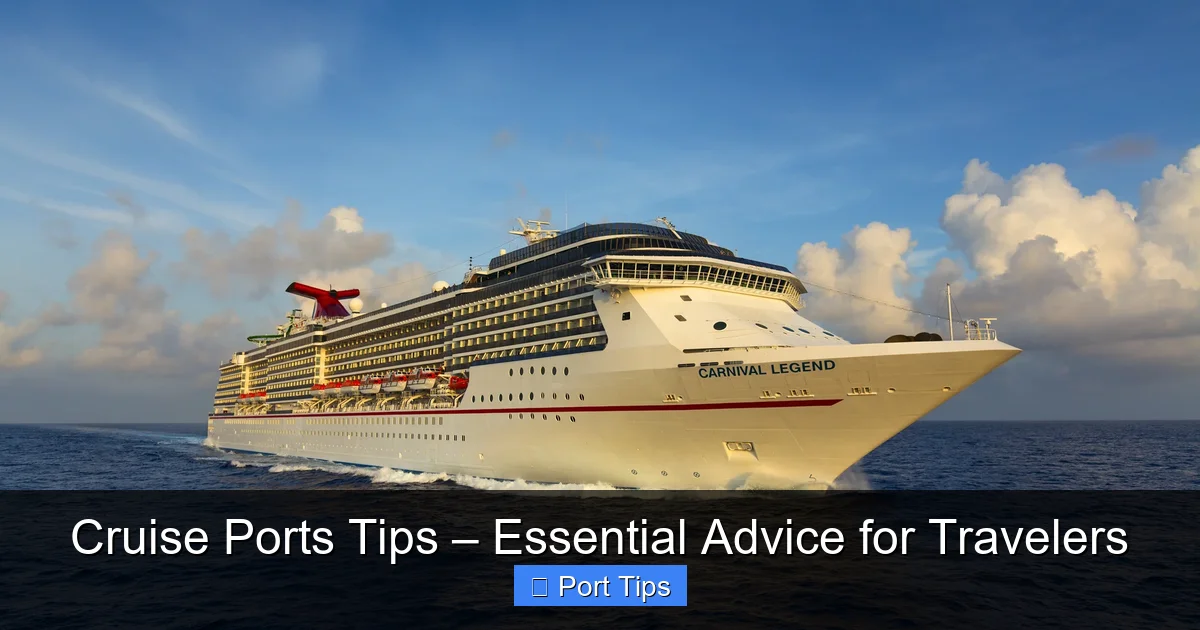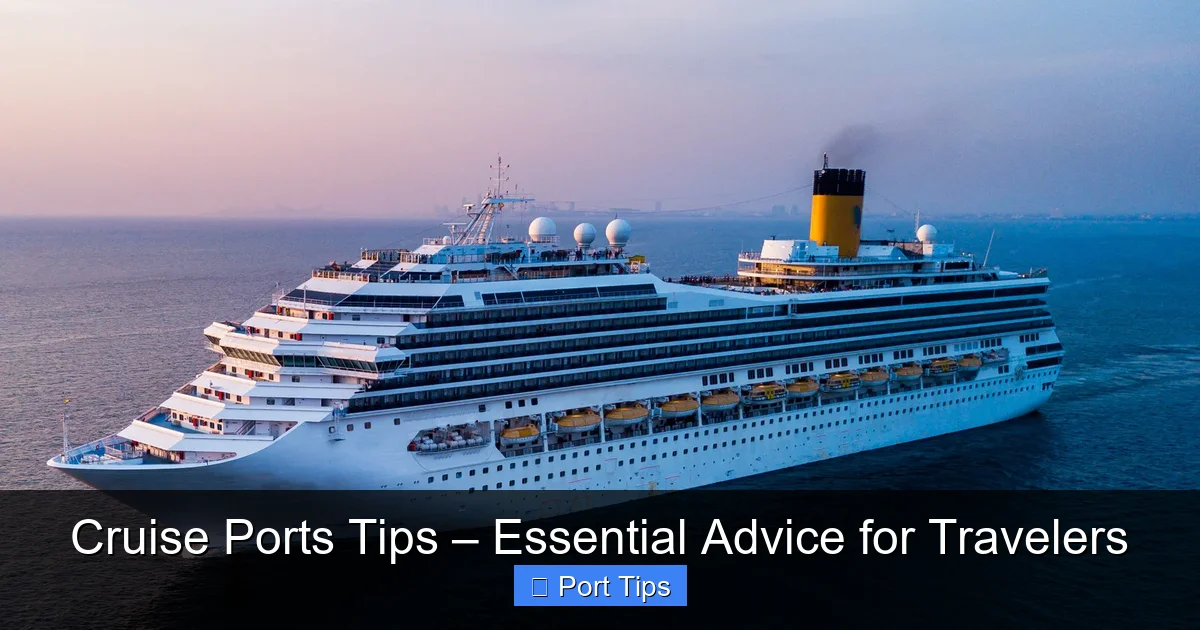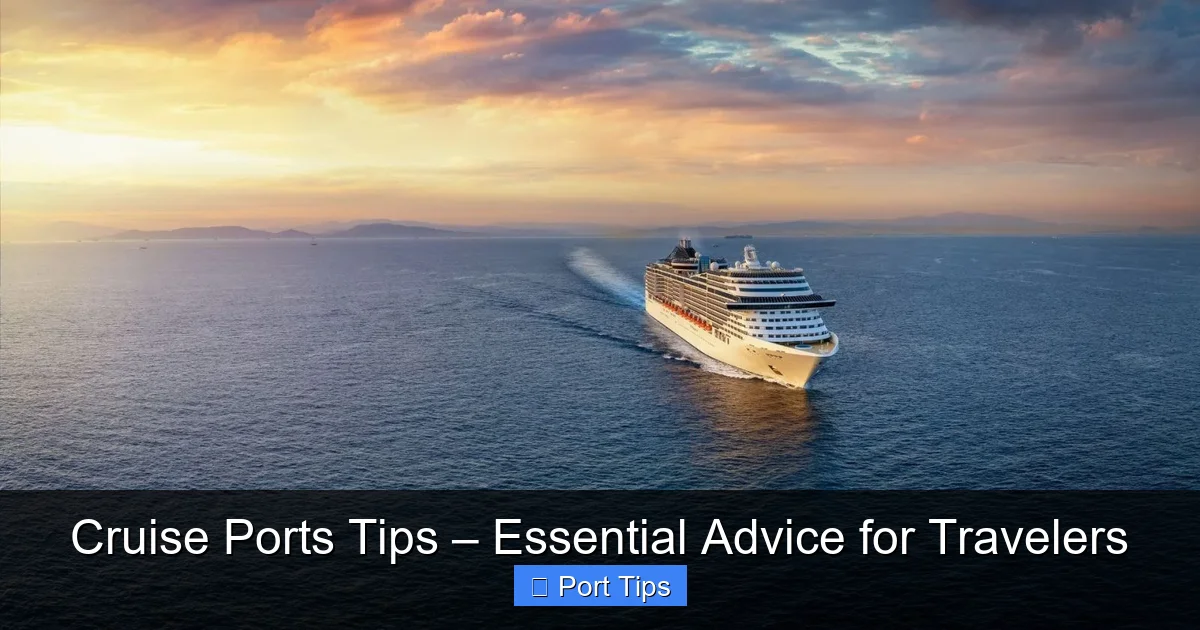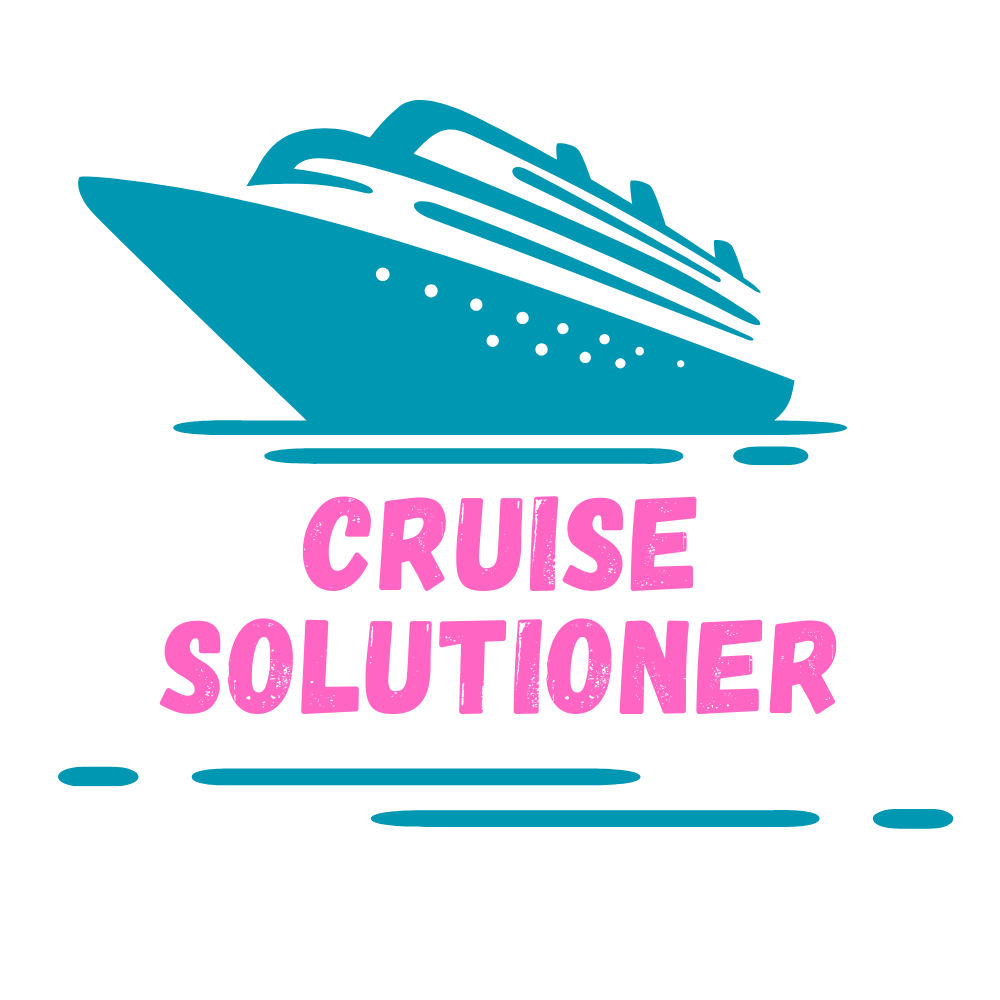
Featured image for this comprehensive guide about cruise ports tips
Image source: static.traveltek.net
Cruise Ports Tips – Essential Advice for Travelers
Ah, the magic of a cruise! Waking up in a new destination almost every day, with a fresh adventure waiting just beyond the gangway. For many, the true highlight of a cruise isn’t just the ship itself, but the incredible variety of cultures, landscapes, and experiences that each port of call offers. Yet, with so much to see and do in limited time, a port day can quickly become overwhelming, leading to missed opportunities or even unnecessary stress. That’s where smart planning and a few insider cruise ports tips come in handy!
Imagine stepping ashore confidently, knowing exactly how to navigate local transportation, where to find the best authentic food, and how to immerse yourself safely in a new culture, all while ensuring you’re back on the ship with plenty of time to spare. This comprehensive guide is designed to empower you with the essential knowledge and actionable strategies to transform every port visit into a memorable, stress-free, and truly enriching part of your cruise vacation. Get ready to unlock the full potential of your port days!
Quick Answers to Common Questions
What’s the top cruise ports tip for planning my day ashore?
Always research your port’s attractions, transportation, and local currency *before* you arrive. This essential pre-planning helps you maximize your time and avoid last-minute stress!
How can I best get around once I’m off the ship, as part of my cruise ports tips?
Look for official cruise line shuttles or reputable local taxis and ride-shares. Be wary of unsolicited offers and always confirm the price before you start your journey.
What absolute essentials should I carry when exploring, according to great cruise ports tips?
Pack light but smart: include sunscreen, a small first-aid kit, a portable charger, and physical copies of important documents like your ship ID and passport info. Don’t forget local currency if needed!
Any crucial cruise ports tips regarding safety and security while exploring?
Stay aware of your surroundings, keep valuables secure and out of sight, and avoid walking alone in unfamiliar areas, especially after dark. Always let someone know your plans if you’re venturing off independently.
What’s the golden cruise ports tip for making sure I get back to the ship on time?
Always give yourself a buffer! Aim to be back at the port at least an hour before the “all aboard” time, accounting for unexpected delays like traffic or long lines.
📋 Table of Contents
Pre-Arrival Planning: Your Port Day Blueprint
The secret to a fantastic port day begins long before you even drop anchor. Thorough preparation can make all the difference between a rushed, anxiety-filled scramble and a smooth, enjoyable exploration. Consider this your essential checklist for crafting the perfect port day.

Learn more about cruise ports tips – Cruise Ports Tips – Essential Advice for Travelers
Image source: explore.com
Research Your Destination
Knowledge is power, especially when you’re in an unfamiliar place. Before you set sail, dedicate some time to researching each of your upcoming cruise ports.
| Cruise Port | Key Tip / Action | Benefit / Insight |
|---|---|---|
| Cozumel, Mexico | Pre-book snorkeling/beach excursions online. | Often 15-20% cheaper than booking at the pier; avoids long queues and limited availability. |
| Santorini, Greece | Utilize the cable car for Fira ascent. | Saves time (3 mins vs. 30-40 min walk/donkey) and avoids strenuous climbs, especially in heat. |
| Rome (Civitavecchia), Italy | Take the train to Rome Termini. | Significantly cheaper (€12-15 train vs. €120-150 taxi); comparable journey time (~1 hour). |
| Nassau, Bahamas | Plan activities in advance and stay in designated tourist areas. | Enhances safety and enjoyment; minimizes risks as certain downtown areas can have higher petty crime rates. |
| St. Maarten/St. Martin | Consider renting a car for the day. | Cost-effective for groups ($40-60/day) to explore both French & Dutch sides efficiently; taxis can add up. |
- Cultural Nuances: Understand local customs, dress codes (especially for religious sites), and basic etiquette. A simple “hello” or “thank you” in the local language can go a long way.
- Currency & Language: Know the local currency and its exchange rate. While major tourist areas often accept USD or credit cards, having some local cash is always wise for smaller vendors or emergencies. Learn a few key phrases like “hello,” “please,” “thank you,” and “how much?”
- Attractions & Activities: Identify must-see landmarks, hidden gems, and activities that align with your interests. Don’t just stick to the top tourist traps; sometimes the most authentic experiences are a little off the beaten path.
- Weather Watch: Check the forecast for your port days. This will help you pack appropriately and plan activities around potential rain or extreme heat.
Shore Excursions: Book Smart, Not Hard
Deciding how to experience a port often comes down to booking an excursion. There are generally two routes:
- Ship-Sponsored Excursions: These offer convenience, guaranteed return to the ship (they won’t leave without you!), and often professional guides. They can be more expensive, and groups might be larger, limiting flexibility. However, for complex destinations or peace of mind, they are an excellent choice.
- Independent Tours/Exploration: Booking directly with local operators or exploring on your own offers flexibility, potentially lower costs, and a more authentic experience. The risk, however, is that you are solely responsible for getting back to the ship on time. This is where careful planning and adherence to cruise ports tips are crucial.
Regardless of your choice, book in advance! Popular tours sell out, especially during peak season. Read reviews, compare itineraries, and confirm what’s included (transport, meals, entry fees). For independent tours, always choose reputable, highly-rated companies.
Essentials to Pack for Port Days
Your carry-on for a port day should be practical and lightweight. Here’s a quick list of port day essentials:
- Small Backpack: For carrying your items.
- Water Bottle: Stay hydrated, especially in warm climates.
- Sun Protection: Sunscreen, hat, sunglasses are non-negotiable.
- Comfortable Walking Shoes: You’ll likely do a lot of walking!
- Light Jacket/Rain Gear: Depending on the forecast.
- Portable Charger: Keep your phone alive for photos and navigation.
- Photocopy of Passport & Cruise Card: Keep the originals safe on the ship, or carry them in a secure, hidden pouch.
- Local Currency & Credit Card: A mix is best.
Navigating the Port: Getting Around Like a Local
Once you step off the gangway, the world is your oyster! But knowing how to get from point A to point B efficiently and safely is key to maximizing your precious time ashore. Understanding your transportation options and staying connected are among the most valuable cruise ports tips.

Learn more about cruise ports tips – Cruise Ports Tips – Essential Advice for Travelers
Image source: images.travelandleisureasia.com
Transportation Options
Upon disembarkation, you’ll typically find a variety of transportation choices. Weigh your options based on distance, cost, and comfort:
- Port Shuttles: Many cruise lines offer complimentary or low-cost shuttles from the pier into the main town center, especially if the port is industrial or far from attractions. This is often the easiest and safest bet.
- Taxis: Readily available in most ports. Always agree on a fare BEFORE you get in, or ensure the meter is running. Use licensed taxis and be wary of unofficial drivers.
- Ride-Sharing Apps (Uber/Lyft): Check if these services are available and reliable in your specific port. They can offer transparent pricing and convenience. Remember, you’ll need data to use them.
- Local Buses/Trains: For the adventurous and budget-conscious, public transportation can be a fantastic way to experience local life. Research routes and schedules in advance. This is a great way to save money on shore excursion planning.
- Walking: In many charming European or Caribbean ports, the main attractions are within easy walking distance of the pier. This is often the most enjoyable way to explore, allowing you to discover hidden alleys and local shops.
- Rental Cars: Generally not recommended for short port stops due to time constraints, unfamiliar roads, and potential traffic, unless you have a very specific, remote destination in mind and a long port stay.
Stay Connected
Staying in touch, whether with your group or for navigation, is paramount for a stress-free port day.
- International Roaming: Check with your carrier, but this can be very expensive.
- Local SIM Cards: A great option for longer stays or multiple ports in the same country. You can often purchase these at the port or nearby.
- Wi-Fi Hotspots: Look for free Wi-Fi at cafes, restaurants, or designated public areas. Be cautious about public Wi-Fi security.
- Offline Maps: Download maps of your port cities onto your phone (Google Maps, Maps.me, Citymapper) BEFORE you leave the ship. This allows for GPS navigation without data.
- Meeting Point: Establish a clear meeting point and time with your travel companions if you plan to split up.
Currency and Payments
Handling money wisely is another crucial aspect of navigating cruise ports effectively.
- Local Currency: While credit cards are widely accepted in many tourist areas, having some local cash in small denominations is essential for markets, street vendors, tips, and public transport.
- ATMs: Locate reputable ATMs (usually at banks) if you need more cash. Be aware of transaction fees.
- Credit Cards: Inform your bank of your travel plans to avoid card freezes. Use cards with no foreign transaction fees if possible. Visa and Mastercard are generally accepted globally.
- Avoid Airport/Port Exchange Booths: Their exchange rates are often less favorable than banks or ATMs.
Maximizing Your Port Experience: From Culture to Cuisine
A port day isn’t just about ticking off landmarks; it’s about truly experiencing the destination. These cruise ports tips will help you dive deeper into local life, savor authentic flavors, and bring home meaningful souvenirs.
Embrace Local Culture
Go beyond the brochure and seek out genuine cultural immersion:
- Beyond Tourist Traps: While iconic sights are great, venture a little further. Explore local neighborhoods, visit a non-touristy park, or simply sit at a cafe and people-watch.
- Local Markets: These are vibrant hubs of local life, offering a sensory feast. You’ll find fresh produce, crafts, and often incredible street food. It’s an excellent place for unique souvenirs and experiencing the daily rhythm of the city.
- Festivals & Events: Check if any local festivals or events coincide with your port day. Participating can be an unforgettable experience.
- Etiquette Matters: Be respectful of local customs. This could mean dressing modestly when visiting religious sites, understanding local greetings, or knowing appropriate tipping practices. A little respect goes a long way.
Savor Local Flavors
Food is a window into a culture. Don’t miss the opportunity to indulge!
- Street Food: Often the most authentic and affordable way to taste local specialties. Look for stalls with long lines of locals – a good sign of quality and freshness.
- Local Restaurants: Avoid restaurants with picture menus and touts outside. Ask local shopkeepers or your taxi driver for their favorite spots. You’re more likely to find delicious, authentic cuisine.
- Dietary Considerations: If you have allergies or dietary restrictions, learn key phrases in the local language to communicate your needs.
- Hydration: Along with sampling local drinks, remember to drink plenty of bottled water.
Smart Shopping & Souvenirs
Bringing home a piece of your journey is wonderful, but shop wisely.
- Bargaining: In some cultures, bargaining is expected, especially in markets. Do so politely and with a smile. In fixed-price stores, it’s generally not appropriate.
- Authenticity: Seek out genuine local crafts and products. Avoid mass-produced items that could have been made anywhere. Talk to the artisans if possible.
- Customs Regulations: Be aware of what you can and cannot bring back into your home country and onto the ship. This applies to certain foods, alcohol, tobacco, and cultural artifacts. You don’t want your cherished souvenir confiscated!
- Shipping Options: For larger items, inquire about reliable shipping services, but be prepared for high costs.
Safety and Security: Protecting Yourself & Your Belongings
While port days are exciting, staying safe and secure is paramount. Being prepared for potential challenges and exercising caution will ensure your adventures remain positive. These safety in cruise ports guidelines are non-negotiable.
Personal Safety First
Your well-being should always be your top priority when exploring new places.
- Situational Awareness: Be aware of your surroundings. Keep an eye on your belongings and the people around you. Avoid getting lost in thought or being glued to your phone.
- Travel in Groups: If possible, explore with at least one companion. There’s safety in numbers, especially when navigating unfamiliar areas.
- Avoid Isolated Areas: Stick to well-trafficked, well-lit areas. If a street feels uncomfortable or deserted, turn back.
- Trust Your Gut: If a situation or person feels off, listen to that instinct and remove yourself.
- Emergency Contacts: Know the local emergency number (e.g., 911, 112) and have the ship’s emergency contact information readily available. Also, note the address of your local embassy or consulate.
Safeguarding Valuables
Petty theft can occur anywhere, so take precautions to protect your possessions.
- Minimize Valuables: Leave expensive jewelry, excessive cash, and unnecessary credit cards locked in your cabin safe.
- Secure Your Essentials: Use a money belt or a cross-body bag worn in front of you for your passport copy, cash, and one credit card. Avoid carrying wallets in back pockets.
- Anti-Theft Bags: Consider backpacks or purses with anti-theft features like locking zippers or slash-proof material.
- Beware of Scams: Be alert to common tourist scams such as overly friendly “guides” who lead you to overpriced shops, “free” gifts that come with a cost, or people creating distractions to pickpocket.
- Don’t Flash Cash: Be discreet when handling money.
Health Precautions
Staying healthy on your port day is just as important as staying safe.
- Sun Protection: Reapply sunscreen frequently, wear a hat, and seek shade during peak sun hours. Sunstroke can quickly ruin a vacation.
- Hydration: Drink plenty of bottled water, especially in hot climates. Dehydration is a common issue for travelers.
- Food & Water Safety: Be cautious with street food in developing countries. Choose establishments that look clean and have high turnover. Only drink bottled or purified water. Avoid ice in drinks unless you’re sure it’s made from safe water.
- Insect Repellent: In some regions, especially tropical ones, mosquito repellent can prevent bites and protect against insect-borne diseases.
- Basic First-Aid Kit: Carry a small kit with band-aids, antiseptic wipes, pain relievers, and any personal medications.
The All-Important Re-Boarding: Don’t Miss the Boat!
You’ve had an incredible day exploring, but the adventure isn’t truly over until you are safely back on board. Missing your ship is a cruiser’s worst nightmare and can be an incredibly expensive mistake. These final cruise ports tips are designed to ensure you never hear that dreaded horn for the last time from the pier.
Know Your All-Aboard Time
This is arguably the most critical piece of information for any port day. Your cruise card, daily planner, and signs at the gangway will clearly state the “all aboard” time. This is NOT the sailing time; it’s the time you MUST be back on the ship. The ship will usually pull up the gangway 30 minutes to an hour before actual departure, giving them time to prepare for sailing. Commit this time to memory, write it down, and set multiple alarms on your phone.
Buffer Time is Your Friend
Always, always, always plan to be back at the ship well before the all-aboard time. A good rule of thumb is to aim to be back at the pier at least one hour before the stated deadline. This buffer allows for:
- Unexpected Delays: Traffic jams, public transport breakdowns, unexpected lines at attractions, or even getting lost can eat up precious time.
- Queues for Boarding: There might be a queue to get back on the ship, especially after a popular shore excursion.
- Security Checks: You’ll likely go through port security and customs upon re-boarding, which takes time.
What if you’re delayed? If you realize you might miss the ship, contact the ship’s local agent immediately (their number is usually on your daily planner or cruise card). They might be able to offer guidance or inform the ship of your situation, though there are no guarantees.
Port Security & Customs
Just like at an airport, expect security protocols when re-boarding the ship. You will need to show your cruise card and possibly your passport. Your bags will go through an X-ray scanner, and you might pass through a metal detector. Be prepared to declare any items purchased, especially alcohol or certain food products. The ship has its own rules about what can be brought onboard, which might differ from a country’s customs regulations (e.g., no raw fruit/vegetables or specific alcohol limits).
Conclusion
Every port of call on your cruise itinerary holds the promise of discovery, adventure, and unforgettable memories. By applying these comprehensive cruise ports tips, you’re not just a passenger; you become a confident, prepared, and savvy traveler ready to embrace each new destination fully. From meticulous pre-planning and efficient navigation to deep cultural immersion and unwavering safety awareness, you now possess the blueprint for truly maximizing your time ashore.
Remember, the world is waiting for you! So, do your research, stay vigilant, be respectful of local customs, and most importantly, soak in every single moment. With these insights, you’re ready to transform every port day from a simple stopover into a highlight of your incredible cruise journey. Happy travels, and may every port bring a new and wonderful story to tell!
Frequently Asked Questions
What’s the best way to plan my day when visiting a new cruise port?
Research your cruise port destination in advance to identify must-see attractions, local cuisine, and transportation options. Consider booking shore excursions through your cruise line or reputable independent operators for convenience and guaranteed return to the ship.
How can I efficiently get around when exploring a cruise port city?
Look into various transportation methods available at the cruise port, such as local taxis, ride-sharing apps, public buses, or even walking if attractions are nearby. Always agree on a fare beforehand or ensure the meter is running to avoid surprises.
What are the most important safety tips to remember at cruise ports?
Always be aware of your surroundings, keep valuables secure, and avoid flashing large amounts of cash or expensive items. Stick to well-trafficked areas, especially after dark, and trust your instincts if a situation feels unsafe.
What essential items should I always carry with me when I disembark at a cruise port?
Carry your cruise ID, a government-issued photo ID, a credit/debit card, and a small amount of local currency for smaller purchases. Also, bring a fully charged phone, sunscreen, and a reusable water bottle to stay hydrated.
Do I need local currency, and how can I stay connected at various cruise ports?
While major establishments often accept credit cards, having some local currency is useful for smaller vendors, tips, or emergencies at cruise ports. For connectivity, check if your phone plan offers international roaming, consider a local SIM card, or rely on Wi-Fi hotspots.
What are the key things to remember to ensure I return to the cruise ship on time?
Always be mindful of the “all aboard” time, which is typically 30-60 minutes before the ship’s scheduled departure. Factor in potential traffic, unforeseen delays, and a buffer when planning your return journey to the cruise port.
